Optical fibers are a convenient instrument for robust light transfer. Their low losses have enabled their wide use in long distance telecommunication systems while service providers like AT&T, Verizon and alike have adopted this technology as the de-facto standard. With the wide adoptions of this technology, fiber production has also seen rapid advances thanks to the preform technology that makes it easy to draw long fibers.
Moreover, their low interference with the external environment and flexible transfer makes them well suited to expand their applications into the medicine. In medicine, fibers deliver light to the target region for cutting or heating purposes. They can also be used as pressure sensors. Additionally, because of their immunity to external electromagnetic radiation, they can be used during MRI procedures when other electronic sensing mechanisms may be hard to employ.
In this article, we will discuss the different types of optical fibers, characteristics to consider for medical applications, and some of their interesting uses in imaging systems and as sensors. In a previous FindLight blog post we have already discussed its applications in Optical Coherence Tomography and endoscopy.
How Does Light Propagate through Optical Fibers?
Fibers guide light by so-called total internal reflection (TIR) which is an optical phenomenon where a light incident upon a boundary of two mediums will experience a 100% reflection at some critical incidence angles if the medium through which is travelling has a higher index of refraction than the medium it is approaching. In fibers, the core consists of a region with higher refractive index than the surrounding which is called cladding. Because of TIR, light gets reflected from the core-cladding boundary and stay within the confines of the core region.
Fibers, which cores are smaller than 10 um, support only single mode of light propagation and are called single-mode fibers. Multimode fibers, on the other hand, are larger than 10 um, and support multimode propagation. Geometric optics can be used to gain insight of the propagation in such fibers. The image below shows the two fiber sizes with TIR illustrated in the multi-mode fiber.
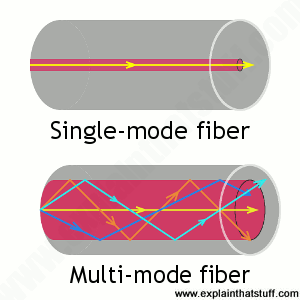
Single and multi mode fibers.
Types of Optical Fibers
a. Silica Based Optical Fibers
Optical fibers are usually made of glasses. Glasses are amorphous materials satisfying a certain unique set of properties. Silica based glasses are the most common. Silicon and oxygen bonds are the most common, with materials such as germanium used for doping to raise the refractive index of the core. Their index of refraction is around 1.5 yielding a 1 percent difference between the core and the cladding, which is sufficient for total internal reflection.
Silica optical fibers have absorption losses in the UV and IR region. The most optimal wavelength for low losses is around 1.5 um, making this a “magic wavelength” for telecommunications. This explains why most telecom lasers are operating at ~1.5um wavelength.
To enable medical applications, engineers are able to vary the OH concentration, thus modifying the absorption spectrum. The image below shows the various regions in spectrum using for heart, skin, and kidney operations.
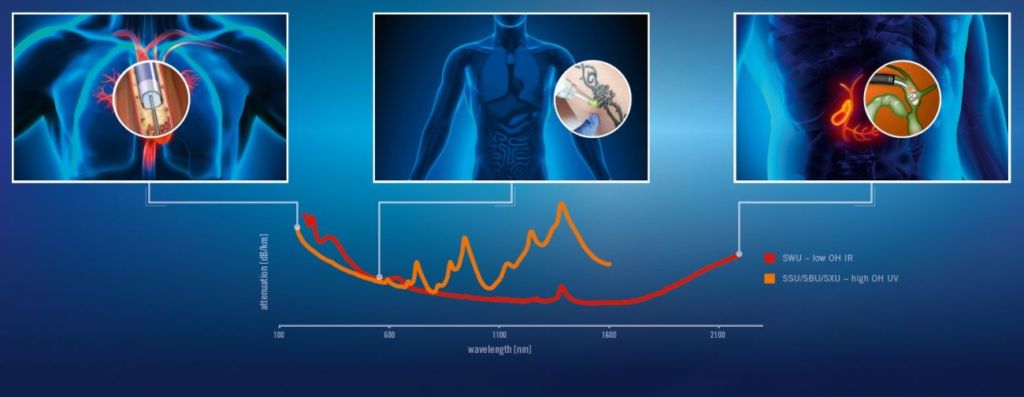
Silica fibers for heart, skin, and kidney operations. Courtesy Heraeus
b. Fluoride Based Optical Fibers
Fluoride based optical fibers were initially proposed for lowering optical losses in the mid-IR region. They are made from compounds of fluorine with metals. To illustrate the difference the use of fluorine creates, consider the following absorption spectrum of ZBLAN, a type of fluoride glass, as compared with silica fibers in the plot below.
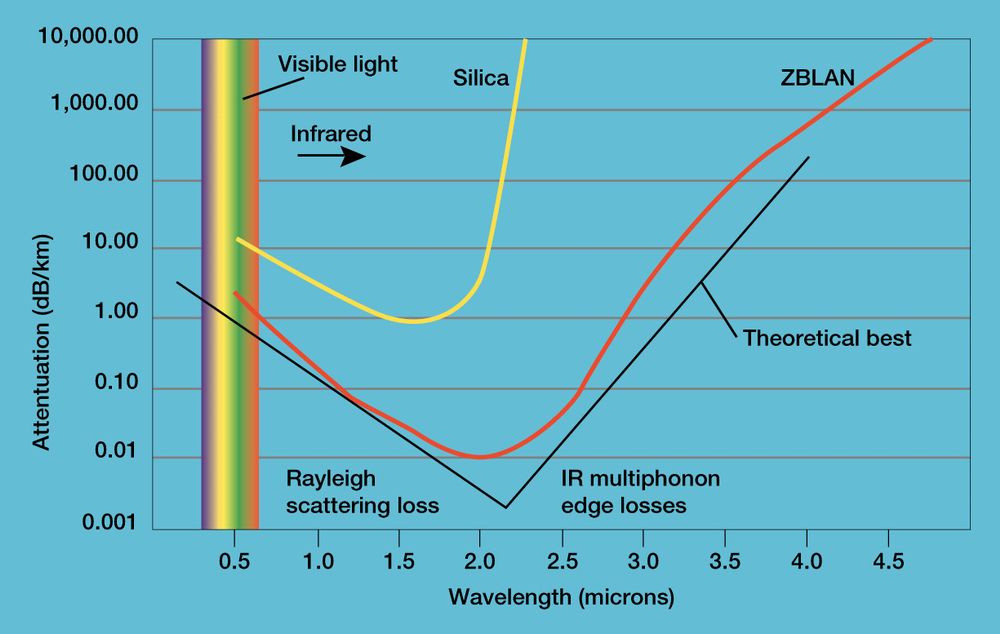
Attenuation spectrum for fluoride glass ZBLAN compared to silica. Image courtesy of Wikipedia.
Fluoride fibers can show better transmission in the mid-IR region. This is useful for YAG lasers in the 2.9 um used in dentistry and ophthalmology.
c. Plastic Optical Fibers
Plastic fibers come with higher losses that silica fibers, but are more flexible and can be fabricated with bigger diameters. This enables many more modes to propagate in multi-mode operation. They have been used in optogenetics for visible light delivery. They are also cheaper to fabricate and maintain than silica fibers.
d. Microstructured Optical Fibers
A relatively new class of fibers are microstructured fibers, also referred to as photonic crystal (PhC) fibers. They consist of the cladding region design in a specific pattern to guide light by mechanisms other than total internal reflection. Because of this different mechanism, they can guide light strongly with reduced losses in bends. Higher bandwidths with operation in the infrared or visible region can be made by changing the microstructure pattern. The image below shows a microsctructed fiber with a concentric photonic crystal cladding.
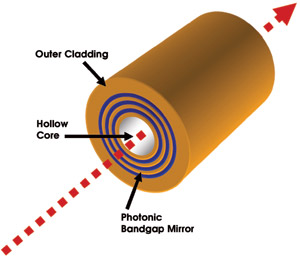
Microstructured fiber for CO2 laser light delivery. Courtesy PhotonicsMedia
The cladding in this case functions as a Bragg reflector. The length of each stack can be chosen quarter of the center frequency of operation, while the number of stacks increases the bandwidth. Beams of CO2 lasers, that are used in heart surgery can be delivered using such PhC fibers instead of the conventional handpiece, which is bulky and not flexible.
Applications of Optical Fibers
1. Fiber Sensors in Medicine
Fibers should be chosen based on the size, wavelength, and power capability for a particular medical application, based on the various fibers types and sizes discussed above. Apart from delivery of light, fibers can also used for sensing applications. These types of applications require especially low loss fibers for the best imaging analysis. Optical Fibers an be used in conjunction with a number of sensing mechanisms such as physical, chemical, biological, or imaging (see table below).
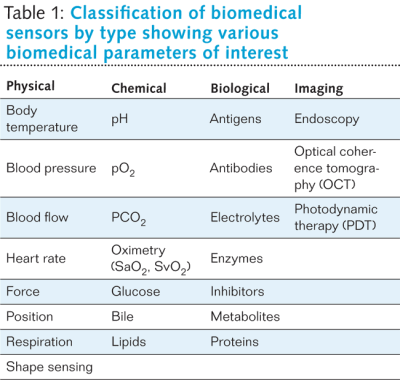
Medical parameters sensed using fiber optics. Image courtesy of LaserFocusWorld
Fiber sensors are especially well suited to be used as high quality sensors with low external interference. There are two categories of sensing mechanisms: intrinsic and extrinsic. The intrinsic sensor measures the changes in the input light by the output parameter with the light not leaving the fiber. Typically this involves changes in the refractive index matrix by the external parameter of interest. In contrast, an extrinsic sensor uses the light to cause the region of interest to undergo a change and send light back for sensing. The image below sketches both methods.
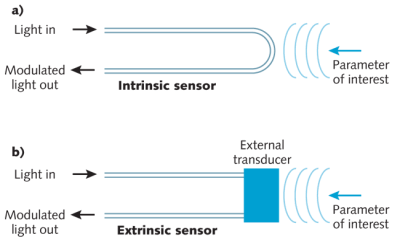
Intrinsic and extrinsic fiber optic sensors. Courtesy LaserFocusWorld
2. Photoacoustic Sensing
A novel sensing technique using photoacoustic effect can be used for low noise imaging of a tissue region. As shown in the setup below, the tissue region is illuminated with a light source. The light in the nearby fiber is modulated by the acoustic waves generated from heating the region, which can be sensed.
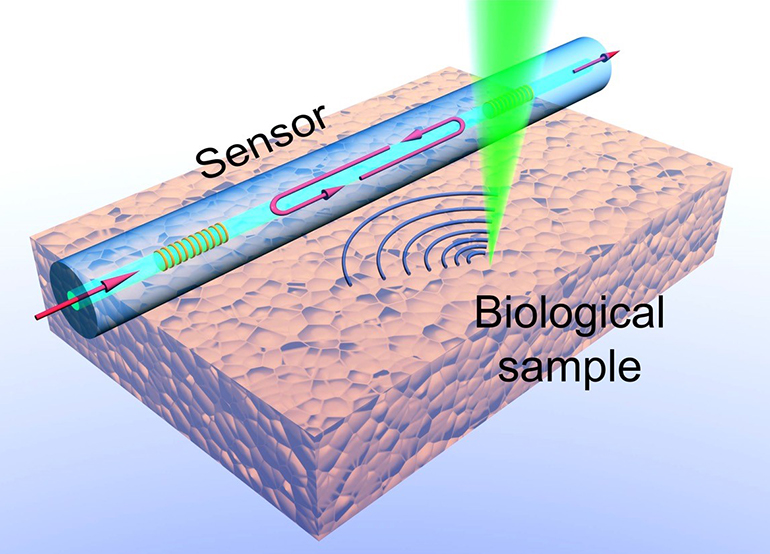
Acoustic waves sensed using fiber optics. Courtesy MedGadget
In photoacoustic effect, the acoustic waves causes changes in the refractive index matrix inducing birefringence of the waves. Sensing birefringence can be done by measuring the change in the polarization of the modulated wave with respect to the input.
3. Optogenetics
Optogenetics is a exciting new field for studying neuronal activity with precise control of parameters. Visible light is used to control the changes in protein function. The image below illustrates an optogenetic setup with rats.
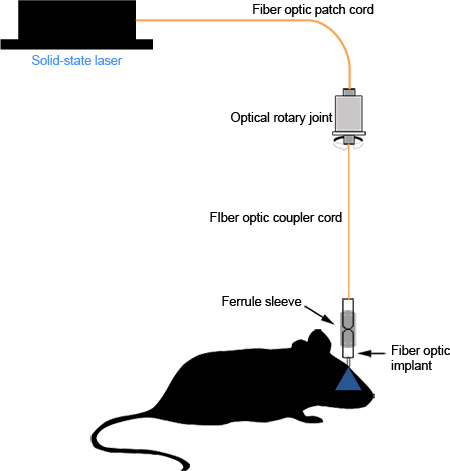
Optogenetic setup using fiber optics. Courtesy NCBI
Fiber optics, in this case help deliver the light to a precise position in the experiment. Usually plastic and silica fibers are used for setups.
Do you have a project that require optical fibers in your design? Check out FindLight’s vast inventory of fibers for delivery and sensing applications.
